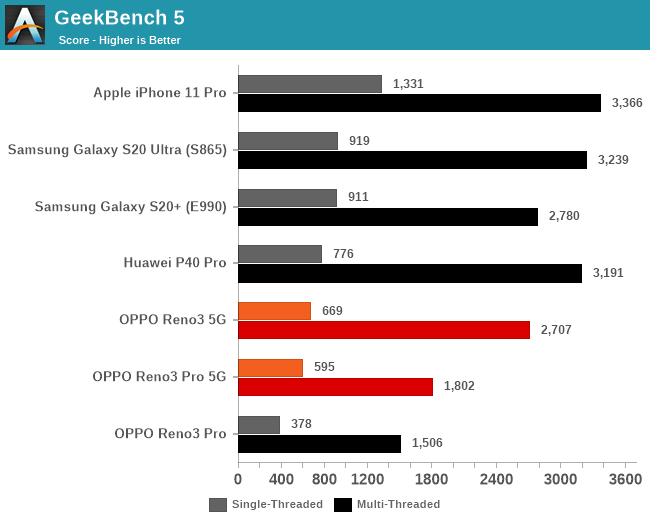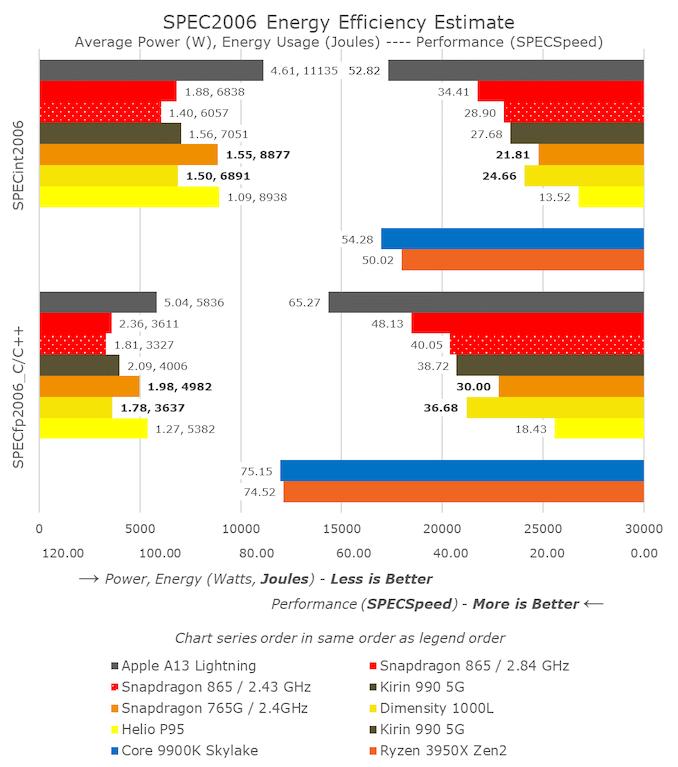OPPO's Reno3 5G vs Reno3 Pro vs Reno3 Pro 5G: Why Don't We See More MediaTek Dimensity 1000 Phones?
by Andrei Frumusanu on August 10, 2020 10:00 AM ESTSnapdragon 765G vs Dimensity 1000L
The positioning of the Snapdragon 765 Reno3 Pro 5G versus the Dimensity 1000L Reno3 5G is an extremely interesting one. By all means, the regular Reno3 is supposed to be the lower-end device and in fact does cost less than the Pro variant of the phone. Logically, we would expect OPPO here to choose the lower-end SoC for the Reno3 whilst the Reno3 Pro gets the better performing chipset. Although that’s what everybody would assume at first glance, things aren’t quite as straightforward.
The although the two devices and SoCs are seemingly positioned close to each other, they’re very different in terms of CPU capabilities. There are two factors at play here: first of all, the MediaTek chipset outright has a core-count advantage over the Qualcomm design by simply having four big cores instead of only two. That’s already a major difference and usually the kind of differentiation you’d expect from SoC at different class categories.
Secondly, MediaTek’s design uses newer Cortex-A77 cores whilst the Snapdragon uses last year’s Cortex-A76 IP. The Cortex-A77 is generally 25% better clock-for-clock compared to its predecessor, which seemingly compounds the processing power ability difference between the two SoCs and Reno3 phones. Qualcomm does have an advantage in terms of clocks speeds which does slightly make up some of this difference: at 2.4GHz on one of the Cortex-A76 cores it’s 200MHz ahead of the MediaTek chipset, which should reduce the expected performance gap a little bit.
Another big difference between the two SoCs is the fact that MediaTek uses TSMC’s 7nm node, while the Snapdragon 765 is manufactured on Samsung’s 7LPP node, with the only other public silicon out there manufactured on this process technology being Samsung’s own Exynos chipsets.
Comparing single-threaded performance between the two SoCs, we see the expected performance gap between the two designs materialise in the measured results. In SPEC2006, the Dimensity 1000L outperforms the S765 by respectively 13% and 22% in the integer and floating-point suites.
Furthermore, the Dimensity-powered Reno3 5G is able to do this whilst consuming less power and energy than the Qualcomm chipset. Generally, we expect this difference to be process-node related as we highly suspect Samsung’s 7nm node being less power efficient than TSMC’s process technology.

Whilst we don’t usually run SPEC in rate mode (multi-process test), GeekBench5 very much showcases the multi-threaded performance advantage that the MediaTek-powered Reno3 5G has over the Reno3 Pro 5G: With a score of 2702, it’s 50% faster than the 1802 score of the Snapdragon 765.
The one area where I did note that the Snapdragon chipset outperforms the Dimensity counterpart is memory latency. On the part of the CPUs, the Qualcomm chipset seemingly has a lower latency memory subsystem that allows it roughly a 13% latency advantage in full random DRAM memory accesses – or around 22ns at a test depth of 128MB.
The memory characteristics between the two SoCs are quite different, as the MediaTek chipset does showcase stronger CPU-side memory bandwidth, particularly in memory reads that reach up to 19GB/s versus 13.3GB/s for the Qualcomm chipset, with a similar advantage in memory copies, although the Snapdragon seems to have faster accesses and more bandwidth for memory writes.
All in all, until now it seems that the MediaTek powered chipset has a clear advantage in terms of performance and power efficiency, which actually makes sense as the Dimensity 1000L on paper just is a higher specced piece of silicon.












44 Comments
View All Comments
Fritzkier - Thursday, August 13, 2020 - link
Realme X was already discontinued since months ago.Realme releases phones like someone with diarrhea, and only produce it for 6 months at most. Even here, where Realme ranks 4th of smartphone market share, Realme X is nowhere to found.
PeachNCream - Tuesday, August 11, 2020 - link
It would be nice to see more non-Qualcomm phone SoCs out there. In particular just because of the recent Qualcomm DSP vulnerabilities that may never get patched on poorly or not updated phones. Qualcomm has released fixes, but we know all too well how bad things are in a world of disposable handsets.https://www.computerweekly.com/news/252487274/Qual...
Other SoC options may somewhat help prevent these from getting too widespread. Then again, some form of better update deployment would help a lot more and I'm not sure that will ever happen because it probably needs to be done by Google and be baked into Android rather than the fragmented manner its left in now and that has all sorts of implications plus logistical considerations akin to and potentially worse than those that Microsoft faces with PC patches.
TheinsanegamerN - Tuesday, August 11, 2020 - link
You REALLY think that a chinese mediatek chip is going to be more secure then a qualcomm chip? How many vulnerabilities on Mediatek chips have either not been disclosed or never found in the first place because they dont care about older chips?Android security is also not the big scary monster man people make it out to be. Android is relatively locked down in terms of installing software compared to a PC. 99% of android problems are misbehaving facebook installations or people not understanding how to empty their storage correctly.
PeachNCream - Tuesday, August 11, 2020 - link
Sorry, I'm not getting into the anti China racism rhetoric with you. We see enough of that from Duck Trampoline's press briefings.Fritzkier - Thursday, August 13, 2020 - link
He mention that Mediatek are Chinese. Apparently he don't know the difference between Taiwan and Mainland China.NitinYadav251096 - Tuesday, August 11, 2020 - link
I agree with you. But it's time now to bring the MediaTek 5G chipsets in the Indian market and they can do quite well.TheinsanegamerN - Tuesday, August 11, 2020 - link
"Why dont we see more Mediatek"? Well two reasons.1.) Mediatek phones do not support CDMA, so they are a no go in the USA.
2.) Mediatek has a well earned reputation for producing some unspeakably horiffic chipsets. 'unable to run correctly at stock speeds' level terrible. Most brands tend to avoid cheap garbage. Even if Mediatek has straightened out their designs, it will take years before companies trust them enough to use their chips in any halfway expensive phones.
Andrei Frumusanu - Tuesday, August 11, 2020 - link
1) They support CDMA and have had for years.https://www.mediatek.com/news-events/press-release...
https://www.mediatek.com/news-events/press-release...
2) I haven't seen evidence of this. The only times they had issues is when everybody else had issues as well (20nm, so on).
patel21 - Tuesday, August 11, 2020 - link
Combination of Huawei Phones with Mediatek Chipsets is indeed a Synergetic relationship that could give Qualcomm the competition it needs by making Mediatek relevant again.Quantumz0d - Tuesday, August 11, 2020 - link
GNU GPL v2 violator, these phones do not get proper updates and use that Chinese OSes on top. OnePlus had a breach again in 2020 for loss of customer data. Cannot run a Custom ROM on these devices.This MediaTek is trash since start and It has to stay like that unless they open up.